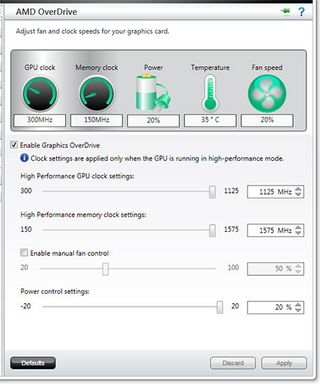System Builder Marathon, March 2012: $1250 Enthusiast PC
Building And Tweaking Around A Radeon HD 7970

When cost is the primary concern, parts rarely seem to fit together ideally. So, we were really surprised at how easily ASRock's P67 Pro3 SE and PowerColor's Radeon HD 7970 fit inside the Apevia X-Trooper Junior case. It turns out that the small enclosure is extra wide and designed specifically to accommodate long graphics cards. A little bit of flexibility in hard drive mounting makes things even simpler. Also, the fact that ASRock's board is skinnier than more ATX platforms helped quite a bit. It’s been a while since I’ve worked with a case this small that didn’t cause some misery when it came time to pack parts inside.

The Apevia X-Trooper Junior isn’t without its flaws, though. Two of the motherboard standoff locations simply weren’t threaded properly, and I had to use brute force to jam them in. Moreover, a lack of cable management makes routing leads and then cleaning up more of a challenge. Those are the only two issues that keep me from recommending X-Trooper to friends and family.
More unfortunate is that our off-the-shelf ASRock P67 Pro3 SE doesn't work properly, refusing to run in dual-channel mode. The Mushkin Redline kit that we bought isn't on this platform's approved memory list; however, we tried modules from Corsair and OCZ as well. None of them got our board working the way it was supposed to. Increasing voltage didn’t help, and so we’re forced to run our tests in single-channel mode. This probably won’t affect the game benchmarks much, but it almost certainly will have a negative impact on memory-intensive application benchmarks.
Overclocking
The 3.1 GHz Core i5-2400 isn’t multiplier unlocked, but it does have to operate within the constraints of a 38x maximum Turbo Boost multiplier ceiling. This allows us to force all four cores up to 3.8 GHz.
That would have been a reasonable tradeoff, considering the Core i5-2400's relatively low price compared to Intel's Core i5-2500K. But because many vendors are now encouraging overclocking through Turbo Boost offsets, the technology remains on all of the time without an option to disable it. So, despite our 38x multiplier setting, our processor ended up running at 3.6 GHz in fully-threaded workloads and 3.7 GHz in less demanding tests. That's better than default, but not quite the 3.8 GHz we wanted.

The PowerColor Radeon HD 7970 was more than happy to hit the core and memory frequency ceilings imposed by AMD's Overdrive tool. Stock 925 MHz core and 1375 MHz memory clocks jumped up to 1125 and 1575 MHz, respectively. We also slid the power control setting to +20%, lowering the chances we'd see throttling under load. This specimen might have overclocked even higher, but we've been having some trouble unlocking higher clock rates in the latest version of MSI's Afterburner utility.

Current page: Building And Tweaking Around A Radeon HD 7970
Prev Page Memory, Hard Drive, And Optical Drive Next Page Test System And BenchmarksStay on the Cutting Edge
Join the experts who read Tom's Hardware for the inside track on enthusiast PC tech news — and have for over 25 years. We'll send breaking news and in-depth reviews of CPUs, GPUs, AI, maker hardware and more straight to your inbox.
-
zanny Sad thing is dollar for dollar the 7970 is maddeningly inefficient. It only says good things for this summer, when hopefully AMD drops the prices on their cards in response to Kepler kicking their collective butts in performance per dollar.Reply -
sempifi99 A 64GB ssd seems very restrictive, can you even load all of the games in the test suite on it? I would think that for any real gamer you would want a SSD at least large enough to load 6 games and considering most modern games take ~10GB there is no room left for windows on it.Reply
For the price, the lack of a larger SSD seems like an oversight. I would think anyone really considering this build would have done better to get a larger SSD and a 7950 or 7870. Or perhaps a single large hybrid HD would be a better option. -
7970 guess you wrote this before the GTX 680 review. No way you'd make that recommendation after.Reply
-
sempifi99 Reply9529252 said:7970 guess you wrote this before the GTX 680 review. No way you'd make that recommendation after.
When you compare their overclocking potentials, they have about the same performance. And then there is the availability of the GTX 680, which is not. So it makes since why the 7970 was chosen.
The 7970 has better compute potential too. But I don't think that is relevant for a gaming box.
-
ksampanna stm11857970 guess you wrote this before the GTX 680 review. No way you'd make that recommendation after.Reply
My thoughts exactly. This story was probably done before Kepler, but now with the 680 launched, the editor sure must be feeling a bit shortchanged.
Of course, the fact that the 680 has disappeared off the shelves is a different story entirely. In any case, within the next few weeks, we should see significant price cuts on the 7970, potentially making this build relevant once again. -
pharoahhalfdead Mushkin, Mushkin, Mushkin... How about trying something along the lines of Corsair XMS3 or another brand? We've seen Mushkin so much, and you sometimes say you want to build different configs, but I never see Corsair in the builds.Reply -
ringzero "Whoa. The Radeon HD 6950s in CrossFire from last quarter's System Builder Marathon beat the Radeon HD 7970 at every combination of resolutions and settings, except 1280x1600 at Ultra details."Reply
I desperately want a monitor at that resolution.
